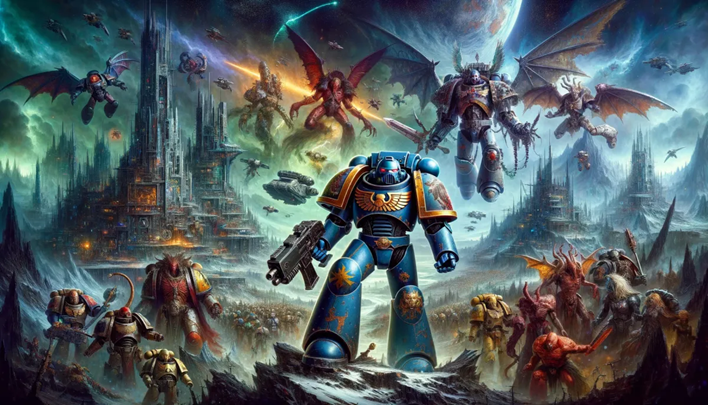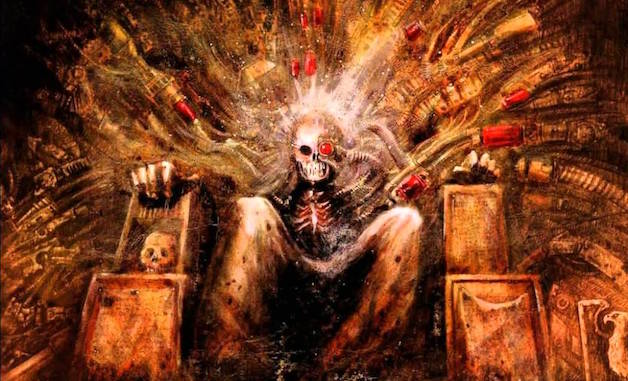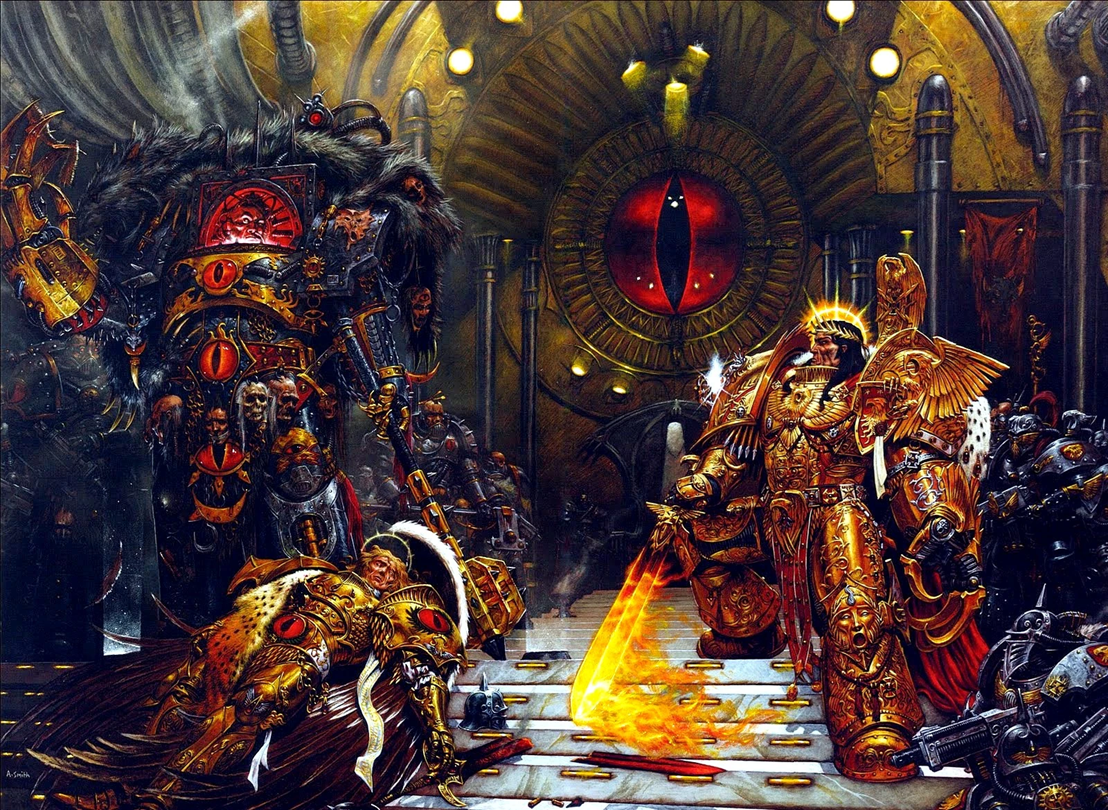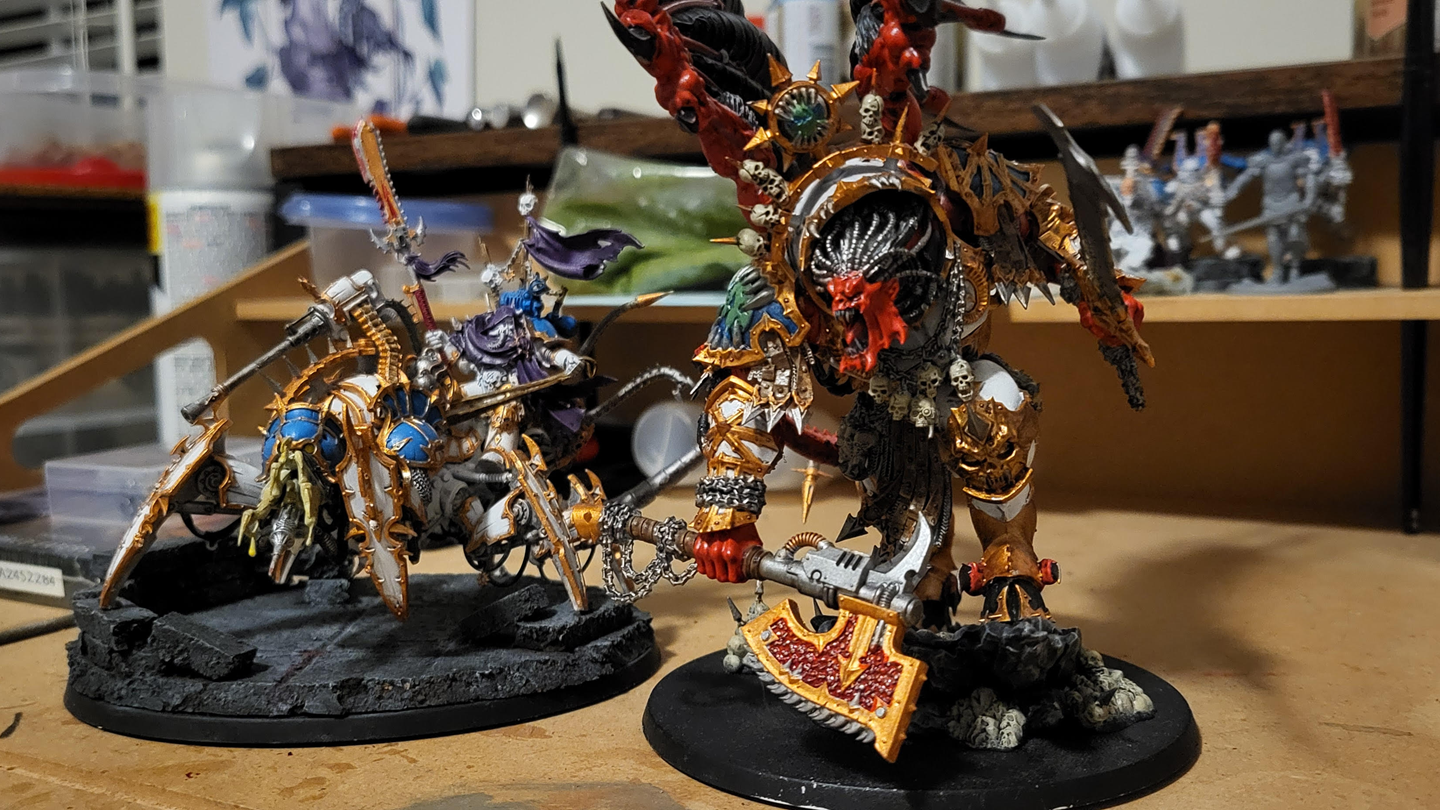
Welcome all, to a fun new thing I’ve decided to do. So for those who might not know, I’ve been a big Warhammer: 40k fan for a while now. Pretty sure I’ve mentioned it in the occasional post, as well as on Discord. Yet despite this, despite playing the table top for a number of years, loving the setting, playing all of the games, and reading plenty of the “modern” novels, I’ve never actually read the definitive story of the setting, the Horus Heresy. Recently however I’ve decided to do just that, and thought it would be fun to do little reviews for each book as I finish them and share my hobby here. I know this isn’t anime, but well… It’s something I’m passionate about, so why not try and something new? Before we get into that though, I need to introduce you to the setting and answer a few questions you might have. Questions like “What exactly is the Horus Heresy?”, “What’s a Space Marine?” and “What do you mean ‘40,000’?”. Well this post is going to answer all of those and hopefully act as a bit of a primer to the Warhammer 40,000 universe, affectionally called Warhammer 40k or just 40k, for those who have been interested but never dared dip their toe into the franchise. So without further ado, let’s dive in to my favorite fictional universe ever!

40,000 Years in the Future
To start, let me give you a famous quote that sums up the setting in about 300 words. You’ve probably heard or read it before, but lets take a look at it again just so we have an idea of what we’re getting into here.
“It is the 41st Millennium. For more than a hundred centuries the Emperor of Mankind has sat immobile on the Golden Throne of Earth. He is the master of mankind by the will of the gods and master of a million worlds by the might of His inexhaustible armies. He is a rotting carcass writhing invisibly with power from the Dark Age of Technology. He is the Carrion Lord of the vast Imperium of Man for whom a thousand souls are sacrificed every day so that He may never truly die.
Yet even in His deathless state, the Emperor continues His eternal vigilance. Mighty battlefleets cross the daemon-infested miasma of the Warp, the only route between distant stars, their way lit by the Astronomican, the psychic manifestation of the Emperor’s will. Vast armies give battle in His name on uncounted worlds. Greatest amongst His soldiers are the Adeptus Astartes, the Space Marines, bio-engineered super-warriors. Their comrades in arms are legion: the Imperial Guard and countless planetary defence forces, the ever-vigilant Inquisition and the Tech-priests of the Adeptus Mechanicus to name only a few. But for all their multitudes, they are barely enough to hold off the ever-present threat to humanity from aliens, heretics, mutants — and far, far worse.
To be a man in such times is to be one amongst untold billions. It is to live in the cruelest and most bloody regime imaginable. These are the tales of those times. Forget the power of technology and science, for so much has been forgotten, never to be relearned. Forget the promise of progress and understanding, for in the grim dark future there is only war. There is no peace amongst the stars, only an eternity of carnage and slaughter, and the laughter of thirsting gods.”
Now reading this, you may think that the universe of Warhammer 40k is edgy nonsense. “Carrion Lord”? “Bio-engineered super warriors”? “In the grim dark future there is only war”? How is this any different from your classic edgy over-the-top Isekai? Well the secret is, Warhammer 40k knows exactly what it is and revels in it. It’s so over the top that it’s basically a parody of itself, and is actually responsible for the existence of the entire Grimdark subgenre of fantasy. There’s no hero complex here, no twist, there aren’t even any “good guys”. Literally every single faction in this universe, from the hyper-fascist zealots of the Imperium of Man or the super-racist Eldar “Space Elves”, to the Communist “Weeb” Tau or universe devouring Tyranid that inspired Starcrafts Zerg, every single one of them is their own brand of evil. And that evil is exactly what makes stories in this universe so fun!
One series you’ll be reading about the heroic defense of a world by the best humanity has to offer, brave souls fighting a doomed battle as the planet cracks beneath their feet. The next you’ll watch a man with industrial-grade imposter syndrome fail upwards in a comical series of events, lampshaded by the dark and gritty nature of the setting, bringing some levity to an otherwise dark and dour universe. Or how about a story about a group of simple soldiers trying to survive in a hostile world, picked off one-by-one by a terrifying monster? Warhammer 40k is vast as a setting, allowing all manner of stories to be told with all manner of allies and foes, all wrapped up in the same over-the-top setting where Gods are killed, billions die daily, and acts of heroism and cowardice are a dime-a-dozen across an unknowable number of conflicts. But there’s one story in particular that stands out as the defining narrative of the setting: The Horus Heresy.

The Horus Heresy
So what exactly is the Horus Heresy and why is it so important? Well with that surface-level knowledge of the setting, not diving into any details about any of the factions or how they work, you’re prepared for a bit of background. You see 10,000 years ago, yes 10,000 so this would be the 31st Millennium, humanity was in its ascension. We had just crawled out of the Dark Age of Technology, a period of collapse after rogue AI destroyed any semblance of unity or cohesion amongst the many worlds we had colonized. The Emperor of Mankind, an immortal demi-god responsible for uniting the warring techno-barbarians of Earth, or Terra, under a single banner is currently enacting a Great Crusade across the galaxy to unite the disparate human civilizations spread out across the stars. Some of these are peaceful, as they welcome the reconnection with their lost siblings. Others are bloody, brutal wars of conquest, either against other human empires that have arisen or against foul aliens who bar their path. And helping him with this task are his 20 18 sons, the Primarchs.
I won’t go into each of them, we’ll learn who they are over the course of the books as they are introduced. The important thing to remember is that each Primarch is basically a demi-god in their own right, bio-engineered by the Emperor to be perfect. Taller than any mortal man, smarter, stronger, grander, and the base for further bioengineered soldiers based on them. Inevitably however, each ended up with their own defects and imperfections. Whether it be due to circumstance, such as being lost on a world of gladiators and having their ability to fell any emotion that isn’t anger removed, or by messed up bio-engineering. The greatest of these sons, the one closest to the Emperor and so beloved that he was named Warmaster of the entire crusade, was named Horus. Horus Lupercal, Primarch of the XVIth Legion called the Luna Wolves, later known as the Sons of Horus and later still as the Black Legion.
As you can guess, Horus eventually turned on his father, the Emperor of Mankind, for a variety of reasons. Some were valid, such as disagreeing his edicts or pushing back against his secrecy. Others were not, like the warping, mind altering effects of Chaos. We’ll get into those reasons as we read the books. The important thing is that Horus decided to commit a Heresy, turning against the Empire and waging war against it, bringing 8 of his brothers along with him and starting an inter-galactic conflict that plunged the galaxy into chaos that is still rippling across the galaxy to this day. And that war, from start to finish, is called the Horus Heresy and is what this series covers.

The Tabletop AKA Plastic Crack
Finally I want to talk a bit about the tabletop. This has absolutely nothing to do with the lore and more to do with the hobby this setting is built around. As a hobby, Warhammer 40k is half table top war-game, half arts and crafts. Most people are probably aware of the former, of the complicated rules and big battles, the expensive models and mountains of plastic. And while that’s all true, it’s also important to remember that many of these battles are stories in and of themselves. Narrative games, grand campaigns, some battles even effect the lore of the setting itself, with Games Workshop having events where the outcome of the battle become canon in the universe! The point is, part of the fun in these battles is that the characters, units and locations all have lore significance, bringing additional meaning a lot of war games don’t have.
The other half of the hobby is the painting and modeling side. This is the one I enjoy the most, as it’s something you can do in your own time and you can create some truly stunning pieces of art. Plus, once it’s done you get to play it on the table and see it march across the battlefield, laying waste to your enemies army with models unique to you and you alone. Do you want to create your own Space Marine chapter? Or imagine members of a traitorous legion that didn’t turn against the Empire and still fight for it to this day? Or maybe you want to play as the Tyranids, creating a unique Hive Fleet invading the galaxy a new. The point is, the painting and modeling side lets you engage with the lore and setting directly, creating something that still fits into the universe but is wholly your own. And that’s not something a lot of other properties allow you to do.
So yeah, that’s a short introduction to Warhammer 40k and the Horus Heresy, both as a setting and a hobby! My next post will be about the first book in the series, Horus Rising by Dan Abnett. This will kick off our journey into the 64 book long event, so feel free to read along or just check in for the posts and see how it’s going.
